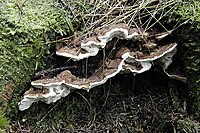
Photo from wikipedia
The increase of wood decay due to the fungal pathogen Heterobasidion annosum is expected to increase the vulnerability of tree stands to wind damage due to the decrease in tree… Click to show full abstract
The increase of wood decay due to the fungal pathogen Heterobasidion annosum is expected to increase the vulnerability of tree stands to wind damage due to the decrease in tree anchorage (by wood decay in roots) and stem strength (by wood decay in stem wood). In this work, we developed a framework to simulate the effects of wood decay by Heterobasidion annosum on the vulnerability of Norway spruce (Picea abies (L.) Karst.) stands to wind damage in terms of uprooting and stem breakage. We also demonstrated the model performance by using tree- and stand-level sensitivity analyses. The increase in the amount of wood decay decreased the predicted wind speeds needed for both uprooting and stem breakage of trees and increased the predicted amount of wind damage. The probability of uprooting was higher than stem breakage for infected trees, which was opposite to the findings for the healthy trees. Because of some simplifications in the modelling due to the lack of proper experimental data (e.g., effects of wood ...
Journal Title: Canadian Journal of Forest Research
Year Published: 2017
Link to full text (if available)
Share on Social Media: Sign Up to like & get
recommendations!